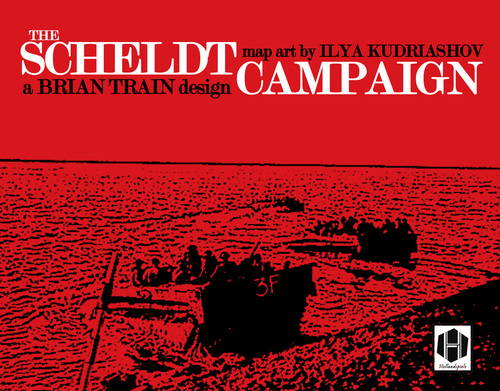WARGAME WEDNESDAY: The Scheldt Campaign by Hollandspiel Games
Wednesday , 16, November 2016 Wargames 3 Comments Fans of World War II history, asymmetrical warfare, and microgames will rejoice: Brian Train’s The Scheldt Campaign is back!
Fans of World War II history, asymmetrical warfare, and microgames will rejoice: Brian Train’s The Scheldt Campaign is back!
The Player’s Aid has the full scoop; what I find so intriguing is the Staff Card system:
Each player has a C2 Level which represents the maximum number of Staff cards he may have in his hand at any one time. The current C2 Level also determines how many Tactical Units the player may have under command of a single Task Force HQ at one time. Also, the mix of Staff Cards differs between the German and Allied sides.
Each Player selects his hand of Staff Cards from those in his Available Pile during his Planning Phase at the end of his Player Turn. Cards remain in your hand until played or your ensuing Planning Phase, at which time you keep or discard any cards in your hand and then select back up to your current C2 Level (thus planning out your next turn).
There are never enough Staff Cards so you have to balance out the need to push on vs. the risk of burning out your front line units. I liked this aspect of forcing hard choices on players, and being able to at least partially script the turn coming… though your choices could be rendered bad ones by the enemy’s selected actions.
The way that these cards interact with the combat system is especially interesting. It sounds like it can produce a great deal of flavor and nuance for very little complexity. Check it out!
—
PaxSims (Simulations)
- Trew: Can Strategy be Playful? (11/12/16)
- Simulation & Gaming (December 2016) (11/12/16)
- A refugee crisis megagame (11/11/16)
- Transition Gaming (11/10/16)
- Something’s Up in Binni! (another McGill megagame) (11/07/16)
- NYT: Play “The Voter Suppression Trail” (11/05/16)
—
Inside GMT (GMT Games)
- Altitude in Skies Above the Reich (11/12/16)
- Next War: India-Pakistan – Strategic Choices, part 3 (11/10/16)
- The Last Hundred Yards Example of Play – Part 2 (11/08/16)
- B&T Biweekly Issue #5: From Bellin’s Map to B&T’s Game Board: How I Use Cartography in Game Design (11/05/16)
- Colonial Twilight: Operations and Special Activities (11/03/16)
—
- Infantry Guns – Graviteam Tactics: Drive on Voronezh (11/11/16)
- Flashpoint Latvia Episode 7 – Steel Beasts ProPE – Hit and Run (11/08/16)
- Looking for a Scourge of War Waterloo Multiplayer Session? Find it at the Dogs of War Virtual Unit (11/08/16)
- Scourge of War Waterloo – Ligny DLC – A Virtual Tour of the Sombreffe Position (11/07/16)
- DCS World 1.5 Mig-21bis – Flares That Lit the Fires Inside (11/06/16)
- Flashpoint Latvia Episode 6 – Arma 3 – The Eve of War (11/04/16)
—
Ludic Futurism (Brian Train)
- Interview on The Player’s Aid: The Scheldt Campaign (11/14/16)
- Tr…… (11/10/16)
- Home from BottosCon 2016! (11/07/16)
- New post on InsideGMT: Colonial Twilight Operations and Special Activities (11/03/16)
—
VASSAL (News)
- New Module! The Twelve Doctors (11/11/16)
—
War in a Box (Warren Abox)
- Miniature Monday: Clerical Skills (11/14/16)
- Moving Day, Helping a Friend (11/11/16)
- Miniature Monday: Wizards (11/07/16)
- Wierdo Beardos In the Lead (11/06/16)
—
The Players Aid (Grant A. Kleinhenz)
- Interview with Jerry White Designer of Enemy Coast Ahead: The Doolittle Raid by GMT Games (11/16/16)
- Asmodee Previews Kushite Witch Hunters & Dice Pack Expansions for Conan (11/15/16)
- Unboxing Legion Wargames’ Redvers’ Reverse (11/15/16)
- Interview with Brian Train Designer of The Scheldt Campaign by Hollandspiel Games (11/14/16)
- Star Wars Edge of the Empire Roleplaying Game Campaign Log #6 – Digging Up the Past! (11/13/16)
- Unboxing GMT’s Silver Bayonet; 25th Anniversary Edition (11/12/16)
- Churchill Big 3 Struggle for Peace Action Point 4 (11/12/16)
- Churchill Big 3 Struggle for Peace Action Point 5 (11/12/16)
- Churchill Big 3 Struggle for Peace Action Point 3 (11/12/16)
- Next Game Up from Osprey Games is The Lost Expedition (11/11/16)
The Staff Card system was introduced by Joe Miranda in Bulge 20 in 2009. It was later heavily adapted and modified for BCT: Kandahar (Modern Conflict Studies Group), Third Lebanon War (BTR Games), and The Scheldt Campaign (Microgame Design Group, Hollandspiele).
This was the first game ever to be published that concentrates solely on the clearing of the Scheldt. Most Europe 1944 games show the Scheldt as a little muddy spot in a corner of the map that someone has to drive through in order to make Antwerp go. This game shows how much was involved in doing that.
I would like to do more with this system; it’s proven very flexible. Got a few other projects on the line right now though.